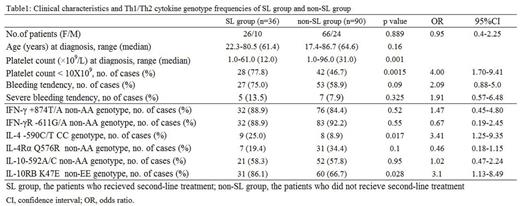Abstract
[Introduction] Immune thrombocytopenia (ITP) is an autoimmune disorder showing T helper type1 (Th1) cytokine polarization. Second-line treatment for ITP is generally used for patients with persistent thrombocytopenia and bleeding tendency after steroid treatment. We have recently shown Th1/Th2 cytokine polymorphisms affect the risk of chronic ITP. However, no previous study has demonstrated the association between Th1/Th2 cytokine polymorphisms and treatment response for chronic ITP. We explored the influence of Th1/Th2 cytokine polymorphisms to the clinical features and treatment response in patients with chronic ITP.
[Patients and Methods] The present study included 126 Japanese patients (92 female and 34 male, median age: 47.7, range: 2.4-82.3 years) diagnosed with chronic ITP according to the criteria of ITP International Working Group. The patient characteristics were summarized in Table1. We examined Th1/Th2 cytokine polymorphisms: INF-g +874T/A, INF-gR -611G/A, IL-4 -590C/T, IL-4Ra Q576R, IL-10 -592C/A, IL-10RA I224V, and IL-10RB K47E using by PCR based method and direct sequencing. Clinical characteristics, including age, gender, platelet number, bleeding tendency, treatment response were also investigated. Second-line treatment was defined as additional therapy after steroid treatment. This study was approved by the Institutional Review Board of Gunma University Hospital.
[Results] We divided chronic ITP patients (n=126) into 2 groups: the patients who received second-line treatment (SL group, n=36) and the patients who did not receive second-line treatment (non-SL group, n=90). In SL-group, the splenectomy was performed in 19 patients (51.4%) and thrombopoietin receptor agonists were given in only 7 patients (19.4%). The clinical characteristics and Th1/Th2 cytokine genotype frequencies of SL group and non-SL group were shown in Table1. The patients in SL group showed severer thrombocytopenia at diagnosis (SL group: median 12.0~109/L vs. non-SL group: median 31.0~109/L, p value=0.001). However, no significant difference was observed between SL group and non-SL group in gender, age, or bleeding tendency. As compared to non-SL group, SL group had significantly higher frequencies of IL-4 -590 CC genotype (low expression type) (SL group: 25.0% vs. non-SL group: 8.9%, p=0.02) and IL-10RB K47E non-EE genotype (low expression type) (SL group: 86.1% vs. non-SL group: 66.7%, p=0.03). Multivariate analysis of requirement for second-line treatment showed an independent significance of IL-4 -590C/T CC genotype (p=0.01) and severe thrombocytopenia (p<0.05). Furthermore, IL-10RB K47E non-EE genotype was associated with thrombocytopenia during the clinical course and requirement for second-line treatments in all patients with ITP.
[Conclusion] Our data suggest that Th2 cytokine polymorphisms, IL-4 -590 CC genotype and IL-10RB K47E, increase the requirement of second-line treatment for chronic ITP.
No relevant conflicts of interest to declare.
Author notes
Asterisk with author names denotes non-ASH members.


This feature is available to Subscribers Only
Sign In or Create an Account Close Modal